The sinkhole that formed under a man’s bed and pulled him in has made a lot of news in Florida, plus another one a few miles away. But the news seems to neglect why those sinkholes are forming. Could it be the same reason sinkholes are forming in Lowndes County, Georgia? And will the Lowndes County Commission do anything about that before we see news about somebody here falling into a sinkhole?
Will Hobson, Laura C. Morel and Jodie Tillman wrote for the Tampa Bay Times 1 March 2013, Seffner sinkhole 911 call: ‘Bedroom floor just collapsed’,
Jeremy Bush just went to bed when he heard what sounded like a car hitting the house. Then screams from his brother Jeffrey’s bedroom.
“Help me! Help me!”
Someone flipped the lights. Jeremy, 36, threw the door open, revealing a sight that defied belief: The earth had opened beneath his brother’s bedroom and was swallowing everything in it. The tip of Jeffrey’s mattress was the only thing left, and it was sinking into a churning sinkhole.
The Tampa Bay Times has a long series on what happened afterwards, rescue workers who didn’t find him, the demolition of the house, objects found, etc. They never quite get around to saying why the sinkhole was there. They first say (Shelley Rossetter 2 March 2013),
There does not seem to be any immediate danger to other structures in the neighborhood.
“We feel the conditions are isolated and there is no indication from the probes that it is anywhere else,” McGillivray said.
Experts are still working to determine the exact cause of the problem.
“My opinion is that this sinkhole has been forming for a while,” McGillivray said. “It may have been caused by erosion of soil down into the limestone.”
One day later, (Shelley Rossetter 3 March 2013),
Early Saturday, officials deemed two homes beside the sinkhole as unsafe also, although they had not been condemned.
Testing at both homes determined they were potentially unstable, Hillsborough County Fire Rescue spokesman Ronnie Rivera said, and the residents of those houses were given 20 to 30 minutes to gather their belongings before being evacuated.
Another day later, (Laura C. Morel, Caitlin Johnston and Patty Ryan 4 March 2013),
New sinkhole forms 2 miles away
As crews began filling the Seffner sinkhole that claimed the life of Jeffrey Bush, a second sinkhole was discovered 2 miles northeast of there Monday. The new sinkhole, about 12 feet around and 5 feet deep in the center, is beneath a fence that divides the grassy side yards of two houses along Cedar Tree Lane near the community of Mango Hills. Hillsborough County spokesman Willie Puz said the two sinkholes are unrelated. “We even had the geologist that was working with us on the first sinkhole look at the area and he was able to determine they’re not geologically connected,” Puz said. “Sinkholes are seasonal and this is just possibly a seasonal coincidence.” One of the houses is vacant and for sale. Residents of the other home were not asked to leave.
“Not geologically connected” and
“seasonal,” huh?
Somebody else tried to explain how sinkholes form,
and claims it was natural causes.
 Melissa Leon wrote for The Daily Beast 2 March 2013,
The Science of Sinkholes: What You Should Know,
Melissa Leon wrote for The Daily Beast 2 March 2013,
The Science of Sinkholes: What You Should Know,
A Tampa man died Thursday when a sinkhole suddenly swallowed his entire bedroom and pulled it deep into the earth. But what exactly is a sinkhole and how do they happen?
Naturally occurring sinkholes, like the one that killed Jeremy Bush, are depressions in the earth caused by water erosion of the bedrock below a land surface. Acidic rainwater seeps through the ground, reaches soluble bedrock (usually salt, sandstone, or a carbonate rock such as limestone), dissolves small amounts, and carries the particles away. Over time (even thousands of years), this process can enlarge natural pores and cracks in the bedrock, to the point where large cavities or caves are formed. And with a gaping hole underground, there’s nothing to support the weight of layers of sediment above—that’s when the ground collapses.
But here are a couple of hints:
As The Atlantic points out,
long periods of drought followed by rain can also set off collapses. Droughts cause groundwater tables to drop, and caves that were once filled with water and were therefore supported by it become weaker. Once rain finally comes, the extra weight of the soaked-through top layer of earth can cause the cave to collapse. And beware of tapping into groundwater for agriculture too, as that can have the same effect as a drought.
Non-naturally occurring sinkholes can form because of water main breaks, sewer collapses, or even abandoned mines. If there’s a substantial change in the weight of a land surface, such as when industrial or runoff-storage ponds are created, underground collapses may also be triggered.
Here’s some news a few years earlier for the same county (from a collection of such stories). ABC Action News, Tampa, reported 22 January 2010, Plant City has already declared 11 homes uninhabitable and are watching 35 more, including Sandy’s. Why those sinkholes under those houses? Craig Pittman wrote for the Tampa Bay Times 26 January 2010, During record cold, farmers used 1 billion gallons of water daily, causing 85 sinkholes,
Farmers in Hillsborough and Polk counties pumped nearly 1 billion gallons of water a day out of the aquifer during the 11-day cold snap this month, causing 85 reported sinkholes in the region and about 700 complaints of dried-up or damaged residential wells, according to figures released Tuesday by the Southwest Florida Water Management District.
See that word the recent stories avoid? “Causing”. As in pumping water out of an aquifer can cause sinkholes. And look what happened just before those recent sinkholes formed. Kathryn Bursch wrote for WSTP News 18 February 2013, Strawberries survive overnight freeze in Plant City,
Plant City, Florida — After a cold night, workers on Monday move up and down green rows reaching for globes of red. Strawberry farmers say their fields around Plant City made it through the dip in temperatures just fine.
As they have in the past, growers sprayed water throughout the night, so an icy coating could protect the delicate blooms and somewhat hardier berries.
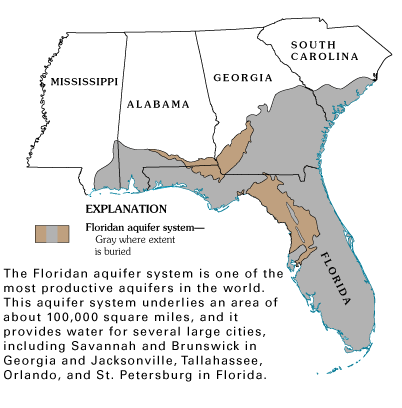
What a coincidence! Once again massive amounts of water pumped out of the aquifer, and once again sinkholes formed, this time one drawing a man to his death. Yeah, sinkholes are seasonal, all right: they seem to form in the season when lots of water is pumped out of the aquifer.
What aquifer are they pumping that spray water out of? The Floridan Aquifer, the same system of porous limestone that we drink out of here in Lowndes County, Georgia.
The City of Valdosta’s PR, Withlacoochee Wastewater Treatment Plant Fully Operational, said:
There is no known connection between the Withlacoochee River south of the Withlacoochee Wastewater Treatment Plant and the Floridan Aquifer, where the City of Valdosta withdraws its drinking water for its citizens. Furthermore, the city’s seven wells, which withdraw the water from the aquifer 300 feet below the surface, are located near the Valdosta Water Treatment Plant Water Treatment Plant, adjacent to and within Freedom Park.
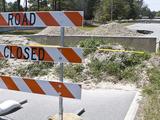 Yes, and a Hillsborough County, Florida spokesman said about
multiple recent sinkholes,
Yes, and a Hillsborough County, Florida spokesman said about
multiple recent sinkholes,
“they’re not geologically connected.”
Except by the Floridan Aquifer.
Remember that sinkhole under Snake Nation Road in Lowndes County that the county had to fix twice in 2011?
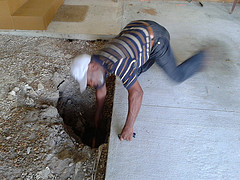 How about the
sinkhole under a garage in Lowndes County,
and
under the yard,
and
under the shed
that didn’t make the news?
How about the
sinkhole under a garage in Lowndes County,
and
under the yard,
and
under the shed
that didn’t make the news?
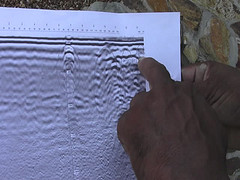 This may also be related to water being pumped out of the aquifer.
In this case, the closest pumper is not the City of Valdosta.
Stay tuned.
This may also be related to water being pumped out of the aquifer.
In this case, the closest pumper is not the City of Valdosta.
Stay tuned.
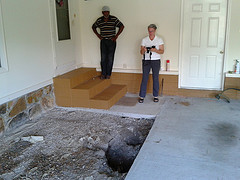 Also stay tuned to see if the Lowndes County Commission
will do anything for Michael McCormick.
Do we really want to see news about someone in Lowndes County
falling into a sinkhole one night?
Also stay tuned to see if the Lowndes County Commission
will do anything for Michael McCormick.
Do we really want to see news about someone in Lowndes County
falling into a sinkhole one night?
-jsq
Short Link:
This is going to be very useful for me thank you very much for posting